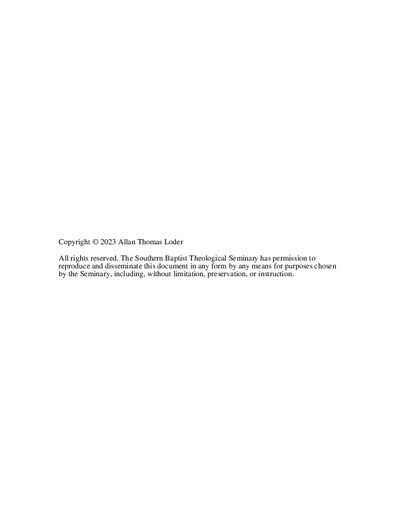| dc.contributor.advisor | Plummer, Robert L. | |
| dc.contributor.author | Loder, Allan Thomas | |
| dc.date.accessioned | 2023-06-02T19:25:22Z | |
| dc.date.available | 2023-06-02T19:25:22Z | |
| dc.date.issued | 2023-05-10 | |
| dc.identifier.uri | https://hdl.handle.net/10392/7105 | |
| dc.description.abstract | While the Gospel of Matthew has long been recognized as having a distinctly “Jewish” orientation, the decades following World War II witnessed a growing interest among scholars asking whether Matthew could be regarded as “anti-Jewish,” or as some would argue, “anti-Semitic.” A survey of scholarly works published in recent decades dealing with this issue reveals that most use the historical-critical and socio-critical methods to determine the most plausible explanation for the presence of so-called “anti-Jewish” elements in Matthew. This study is intended to complement historical-critical and socio-critical studies done by others by employing literary-critical methods to support further the conclusion that Matthew’s so-called “anti-Jewish” elements are best understood as a thoroughly Jewish critique of Jewish opponents within the context of Jewish sectarian rivalry.
This study employs the basic principles of narrative criticism, as outlined by Mark Allan Powell, along with the basic principles of rhetorical criticism, as outlined by modern literary theorists such as George A. Kennedy, Burton L. Mack, and Sonja K. Foss. Special attention is given to the author’s use of character and characterization as rhetorical device. Using a more nuanced approach, this study argues that the Gospel of Matthew may be read as a two-sided rhetorical argument presented in narrative form in which the author uses characters and characterization to represent divergent standpoints and different responses to the claim that God’s plan of salvation for Israel, which now also encompasses all the nations/Gentiles, is realized in and through Jesus the Messiah. Accordingly, Matthew’s so-called “anti-Jewish” elements are to be understood not as commentary on ethnic Jews, nor as a sign of rejection of Judaism, but rather as heated rhetoric used to highlight and explain certain details about the antagonists in his story who represent the antithesis to his argument. | en_US |
| dc.subject.lcsh | Bible. Matthew--Criticism, interpretation, etc. | en_US |
| dc.subject.lcsh | Christianity and antisemitism | en_US |
| dc.subject.lcsh | Christianity and other religions--Judaism | en_US |
| dc.subject.lcsh | Jews in the New Testament | en_US |
| dc.subject.lcsh | Rhetoric in the Bible | en_US |
| dc.title | Responses to the Messianic Claim: Characterization as Rhetorical Device in the Gospel of Matthew | en_US |
| dc.type | Electronic dissertation | en_US |
| dc.type | Text | |
| dc.contributor.committee | Pennington, Jonathan T. | |
| dc.contributor.committee | Cook, William F. | |
| dc.type.qualificationname | Ph.D. | en_US |
| dc.publisher.institution | Southern Baptist Theological Seminary | en_US |
| dc.publisher.department | School of Theology | |

